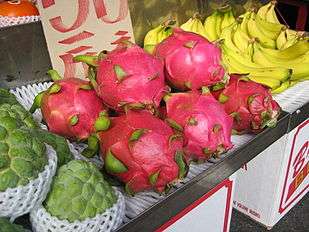Hylocereus undatus
| Hylocereus undatus | |
|---|---|
 | |
| Fruit of Hylocereus undatus | |
 | |
| Scientific classification | |
| Kingdom: | Plantae |
| (unranked): | Angiosperms |
| (unranked): | Eudicots |
| (unranked): | Core eudicots |
| Order: | Caryophyllales |
| Family: | Cactaceae |
| Genus: | Hylocereus |
| Species: | H. undatus |
| Binomial name | |
| Hylocereus undatus (Haworth) Britton & Rose | |
| Synonyms | |
| |
Hylocereus undatus (white-fleshed pitahaya) is a species of Cactaceae and is the most cultivated species in the genus. It is used both as an ornamental vine and as a fruit crop - the pitahaya or dragon fruit. The native origin of the species has never been resolved.
Common names
- English: pitahaya, dragon fruit, night blooming Cereus, Strawberry Pear, Belle of the Night, Cinderella Plant, Jesus in the Cradle
- Estonian: maasik-metskaktus
- French: pitaya, fruit du dragon, cierge-lézard, poire de chardon
- German: Drachenfrucht, Distelbirne
- Greek: Φρούτο του δράκου (fruto tu draku)
- Hawaiian: panini-o-ka-puna-hou ("Punahou cactus") - a famous specimen still grows at Punahou School
- Japanese: pitaya (ピタヤ), dragon fruit (ドラゴンフルーツ),
- Portuguese: pitaia, cato-barse, cardo-ananaz, rainha da noite
- Spanish: pitahaya roja (Colombia, Mexico, Venezuela); flor de caliz, pitajava (Puerto Rico); junco, junco tapatio, pitahaya orejona, reina de la noche, tasajo (Mexico)
- Swedish: skogskaktus, röd pitahaya
- Vietnamese: thanh long
- Thai: แก้วมังกร (kaeo mangkon)
- Malay: buah naga. pronounce:boo-ah naa-gaa
- Chinese: 火龙果; pinyin: huǒlóngguǒ
- Italian: Pitahaya, Frutto del Drago
Etymology
Greek "hyle" - wood, matter, Latin "cereus" - waxen, Latin "undatus" - wavy edges of the ribs.
History

There is a locally famous cactus hedge on a lava rock wall of the Punahou School in Honolulu, the hedge of Kapunahou.[1]
In 1836, Mrs. Bingham planted the hedge[2] of Hylocereus undatus, the famed cactus known in Hawaii as panini o kapunahou. Its exotic blossoms still bloom during the closing summer months on the Punahou walls. The hedge is on two sides of the school and about three hundred meters long.
From July to as late as October the hedge blooms and several times there is a wall of white flowers hundreds of yards long. Supposedly all the H. undatus in Hawaii came from the wall of Punahou School. People used to come in the evenings from all over the island to see them blooming and "borrow" some cuttings so that now they have this species all over the islands.
Origin and habitat
H. undatus is lithophytic or hemiepiphytic. It is widely distributed through the tropics in cultivation. Like all true cacti, the genus originates in the Americas, but the precise origin of the species H. undatus is uncertain and it may be a hybrid. Hylocereus undatus is a sprawling or vining, terrestrial or epiphytic cactus. They climb by use of aerial roots and can reach a height 10 meters or more growing on rocks and trees. The genus is very variable and closely related to Selenicereus.
Systematics
This species is closely related to H. ocamponis and H. escuintlensis.
Description
Dragonfruit stems are scandent (climbing habit), creeping, sprawling or clambering, and branch profusely. There can be 4-7 of them, between 5 and 10 m or longer, with joints from 30–120 cm or longer, and 10–12 cm thick; with generally three ribs; margins are corneous (horn-like) with age, and undulate.
Areoles, that is, the small area bearing spines or hairs on a cactus, are 2 mm across with internodes 1–4 cm. Spines on the adult branches are 1-3, 2–4 mm long, being acicular (needle-like) to almost conical, and grayish brown to black in colour and spreading, with a deep green epidermis.
The scented, nocturnal flowers are 25–30 cm long, 15–17 cm wide with the pericarpel 2.5–5 cm long, about 2.5 cm thick, bracteoles ovate, acute, to 2.5 to less than 4 cm long; receptacle about 3 cm thick, bracteoles are linear-lanceolate, 3–8 cm long; outer tepals lanceolate-linear to linear, acuminate (tapering to a point), being 10–15 cm long, 10–15 mm wide and mucronate (ending in a short sharp point). Their colour is greenish-yellow or whitish, rarely rose-tinged; inner tepals are lanceolate (tapering to a point at the tip) to oblanceolate (i.e. more pointed at the base), up to 10–15 cm long about 40 mm wide at widest point, and mucronate, unbroken, sharp to acuminate (pointed), and white. Stamens 5–10 cm long, are declinate, inserted in one continuous zone from throat to 35 mm above the pericarpel and cream. The style (bearing the stigma) to 17, they are 5-24.5 cm long, stout, 6–8 mm thick, cream, and up to 26 stigma lobes, they can be whole or sometimes split at the top, cream, about 25 mm long. Nectar chambers are 30 mm long.
The fruit is oblong to oval, to 6–12 cm long, 4–9 cm thick, red with large bracteoles, with white pulp and seeds are edible; seeds are black.
Cost
Dragonfruit cost about £1-2.5 each in the UK, PHP 3,000-5,000/kg in Indang, Philippines. In Taiwan they are about 37 NT each, and depending on season, can be found in Hong Kong for 17 HKD for 3 (6.3HKD/per). In Germany they can be found for EUR 2-5 (2015) at some supermarkets.
See also
References
- Anderson, E. F. 2001. The cactus family. Timber Press, Portland, Oregon, USA.
